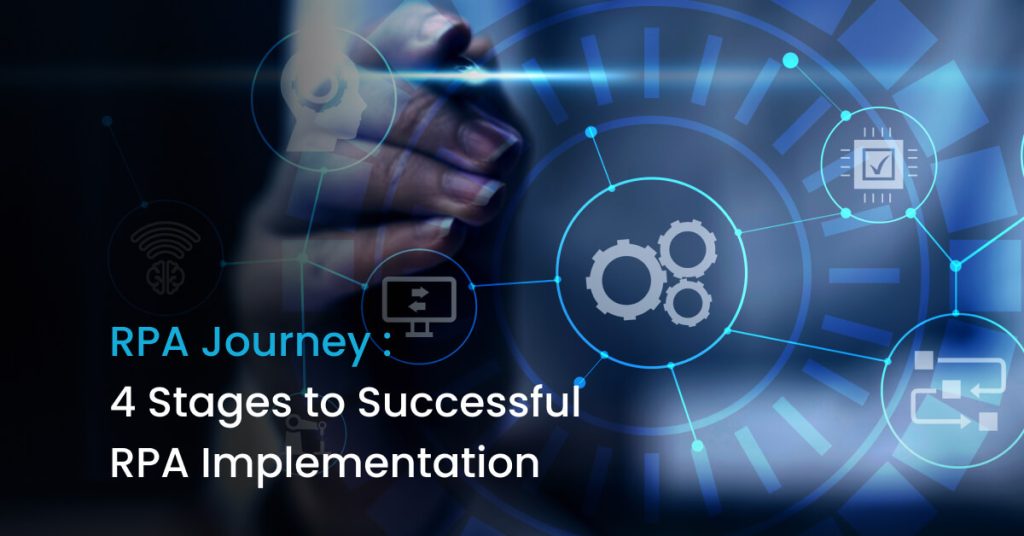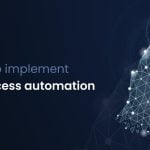
Robotic Process Automation implementation in the need of the hour in world of modern business. This technology is rapidly evolving and making major waves in the 21st century business landscape.
But what exactly is Robotic Process Automation (RPA), and how does it work? How do you go about with rpa implementation? Let us delve into this comprehensive blog to understand the rpa journey every organisation must undertake
Definition of Robotic Process Automation
RPA is the latest software technology designed to simplify and streamline digital tasks, making automation accessible to anyone. With RPA implementation, businesses can create their own digital helpers, known as “bots.” These bots are trained to understand, mimic, and execute rules-based processes, just like a human would. The beauty of RPA implementation process lies in its simplicity; it allows users to build bots by observing and teaching them the tasks they need to perform.
Imagine having a team of tireless, precise, and ultra-efficient workers who never sleep. That is precisely what RPA offers. These software bots can seamlessly interact with various applications and systems, just like human employees. However, they operate nonstop, at lightning speed, and with unparalleled reliability and precision.
Benefits of RPA Implementation
The world of business is a dynamic one, where efficiency and precision are key. RPA brings a multitude of benefits to the table, addressing many pain points that businesses encounter. Let us dive into the seven key advantages of RPA implementation:
1. Saving Time
Repetitive administrative tasks are a common part of many business processes. RPA implementation steps in to automate these repetitive tasks at blazing robotic speed. The result? Your business saves time and resources. Your human employees can now dedicate more of their valuable time to tackling complex, strategic tasks that truly matter.
2. Increasing ROI
The efficiency of RPA tools in managing repetitive tasks surpasses human capabilities. This efficiency boost is one of greatest advantages of RPA journey. With rpa implementation, your business can enhance productivity and gather valuable qualitative and quantitative data over time. This data empowers you to make more informed decisions and manage costs more efficiently, ultimately improving your Return on Investment (ROI).
3. Eliminating Human Error
No matter how skilled an individual may be, human error and fatigue are always lurking. RPA bots, on the other hand, are tireless and highly accurate. They execute tasks precisely every single time, eliminating the risk of costly errors.
4. Elevating Security
In today’s digital age, cybersecurity is paramount. RPA implementation plays a significant role in bolstering your business’s security. By reducing the number of human interactions with sensitive data and information, RPA minimizes the risk of data leaks and breaches. RPA tools also enhance data protection, guarding against unauthorized access and performing automatic account logouts.
5. Increasing Compliance
Regulatory compliance is crucial for the stability and reputation of your business. RPA solutions excel at adhering to established rules and guidelines with unwavering accuracy. This is especially vital for organizations subject to industry and government regulations. RPA not only ensures compliance but also simplifies the auditing process, reducing compliance risks. It can be seamlessly integrated into contract workflows, form updates, and compliance-related notifications, thus ensuring consistency.
6. Scaling Business Process Automation
As your business harnesses RPA roadmap to automate more tasks and processes, automation gradually spreads across your organization. This scalability enables your business to confidently meet seasonal demand fluctuations and achieve projected targets. Whether it is processing orders, managing invoices, or overseeing stock, RPA journey supports growth and efficiency.
7. Enhancing Employee Satisfaction
Automating tedious, repetitive tasks liberates your human workforce to focus on more critical aspects of your business. With the RPA implementation process taking care of routine work, employee satisfaction naturally rises. Workers can channel their skills and expertise towards tasks requiring strategic thinking, such as business planning, public relations, and innovation.
Stages of RPA Implementation
Following are the steps involved in RPA implementation process which can help businesses align and optimize resources for achieving the desired outcomes.
Stage 1: Creating a Proof of Concept (PoC)
The initial stage of your RPA implementation journey is like the foundation of a building. This is where you will explore whether your automation dreams are technically feasible. The PoC serves as the litmus test, allowing you to shortlist the necessary tools, technologies, vendors, and controls required for your RPA journey. In this phase, it is all about finding answers to pivotal questions that set the stage for what is to come:
- Which tool should be considered for automation?
- Is it best to have an in-house team or opt for an external vendor?
- What type of infrastructure aligns with your solution’s needs?
- Are there specific rules and regulations that demand compliance?
- Should you invest in a dedicated automation tool, or can you achieve your goals with a scripting language?
Think of this phase as a strategic SWOT analysis. Your organization will evaluate its strengths and weaknesses in executing processes and uncover external opportunities and threats. For instance, you might wonder whether commercial automation tools like Automation Anywhere, BluePrism, or free/community versions like UiPath or WorkFusion are better suited for your specific use case.
Once you have identified the right tools and processes, the next crucial step is conducting a cost and benefit analysis. This analysis helps you calculate the expected return on investment (ROI) from your automation journey. To do this, consider factors such as the duration for RPA implementation, alternative cost-effective technologies, and the potential profits that the automated process will bring to your organization. These calculations will pave the way for the transition to Phase 2 of your RPA implementation journey.
Stage 2: Run a pilot project
The concept behind running a pilot project is simple: before fully diving into RPA implementation, it is essential to construct a small end-to-end solution in a production environment. This pilot project serves as a litmus test, helping to identify any early risks or potential mismanagement issues that could hinder the organization’s journey.
One key aspect of the pilot project is the involvement of internal and external stakeholders. Their input is gathered through surveys, which become invaluable resources for decision-making. These insights provide a foundation for documenting necessary improvements, identifying risk areas, and revising the methodology and frameworks. The goal is to build a stronger, more efficient solution by addressing any identified issues.
During the pilot project phase, organizations have a unique opportunity to assess the capabilities of their chosen RPA partner. They can put the RPA scripts and bots through their paces, ensuring that they function as intended. Moreover, this stage allows organizations to gain a first look at the solution’s design.
Running a pilot project is a critical and inevitable part of the robotic process automation implementation. It serves as a vital quality control checkpoint and helps set the course for a successful RPA journey. By incorporating feedback from all stakeholders and thoroughly testing the proposed solution, organizations increase their chances of a seamless and effective RPA implementation.
Stage 3: Dry run and bot monitoring
Stage 3, known as “Bot Monitoring and Dry Run,” is the phase where you not only confirm that your bots are operational but also ensure they are finely tuned for optimal performance. This stage serves as a critical checkpoint before your bots are deployed in a production environment. The primary objective of Stage 3 is to assess the functionality of your bots. It is akin to inspecting each component of your machine to ensure it operates seamlessly. Another crucial aspect of this phase involves validating the effectiveness of your log and notification mechanisms. These mechanisms act as the bots’ senses, providing insights into their activities. It is imperative to confirm that these systems function efficiently, promptly alerting you to any irregularities.
Successful completion of Stage 3 extends beyond technical validation. It also serves as a demonstration of RPA’s capabilities to a broader business audience. It is the moment to highlight the value RPA can bring to the organization, potentially garnering support, and enthusiasm for your RPA initiative. However, before granting your bots access to the production environment, a vigilant support and maintenance team must be prepared. They are the unsung heroes ready to address any unexpected bot behavior. This proactive approach ensures the smooth progression of your RPA journey without any disruptions.
Stage 4: Deployment
After successfully executing the above phases, the final outcome is poised to be positive. By the time we reach deployment, the RPA implementation should comply with industry standards and organizational regulations. This ensures that automation seamlessly integrates with existing functionalities within the operational landscape.
For businesses seeking inspiration, consider the case of QatarPost, a company that recently automated their dispatch document creation process using SquareOne RPA roadmap in their operations based in Qatar. The result was nothing short of spectacular—an 80% increase in business efficiency. This real-world example underscores the immense potential of RPA in revolutionizing business operations.
Begin Your RPA Journey with SquareOne
At SquareOne Technologies, we are committed to walking alongside you on your RPA journey. Our four-step RPA implementation process ensures a smooth transition to automation. We understand that RPA is not about reducing manual effort; it is about transforming your business processes and setting you on a path to greater efficiency and profitability.
If the RPA roadmap aligns with your business’s vision, we invite you to set up a free consultation with our RPA experts. We will dive into the nitty-gritty of your operations, demonstrate how RPA can work wonders for your business, and guide you through each step of the implementation process.
Do not just dream about automation; let us make it a reality together. The RPA journey is exciting, and we are here to make sure it is a successful one.

















